エステティクス(美学=感性論)概念を 視座とする「きれい事」の経営実現に関する考察
- 1. 【D4】 エステティクス(美学=感性論)概念を 視座とする「きれい事」の経営実現に関する考察 井登友一 Yuichi INOBORI, Ph.D. 株式会社インフォバーン 京都大学経営管理大学院(民間研究員) yuichi.inobori@infobahn.co.jp 2023年度組織学会研究発表大会
- 3. 3 ● 問題意識 ● 関連する先行研究 ● 先行研究の課題 ● 本研究のリサーチ?クエスチョン ● 研究方法 ● 事例の特徴 ● 事例分析に用いる理論的視座 ● 事例分析 ● 考察 ● まとめ ● 本研究の課題と今後の展望 発表の構成
- 4. 4 企業経営において「経済的実現」と「社会的実現」は両立しうるか? そうであるならば,これら相反する二側面の両立(本研究では「徳倫理的経営」 の実現と表現)のために重要な役割を担うものは何か? 関連研究 ● Taka & Donaldson(1999)「ビジネス?エシックス」に関する議論 ● Nonaka & Konno(2007)「美徳の経営」に関する議論 ● および,Nonaka & Konnoが背景概念とするMacIntyre(2007)のVirtue-ethics(徳倫 理)概念 ● 太田(2019, 2020)のフリードマン?ドクトリン(経営における株主至上主義)的 概念の転換に関する総括的レビュー など 問題意識
- 5. 5 徳倫理的経営の実現と密接な関連をもつ研究 ● 美徳の経営に関する研究(Nonaka & Konno, 2007) ● 「共通善」(common goods)を志向する卓越性(excellence)の追求 ● 本質的な価値を追求し,未来を創り,かつ実践する知的力量を持った経営 ● MacIntyreの徳倫理概念の引用 ● 徳倫理的経営を実現している企業の研究 ● パタゴニア(Sarason & Hanley, 2013; Chouinard & Klein, 2016; Rattalino, 2018) ● ブルネロ?クチネリ(Zsolnai & Wilson, 2016; Cucinelli, 2018) 関連する先行研究
- 6. 6 ● 前述の実践企業を対象とした先行研究の課題 ● 2社ともに,従前の経済パラダイムに対する批判が先に立っている時点で,そ こには新旧の経済体制や経営観が二元論として維持されており,その円環の 中で自社の存在を際立たせるための批判が基底にある ● 両社の創業者が持つ強い信念や理念など極めて属人的なものが多く,かつ 両社が手掛ける産業領域(ラグジュアリー産業や地球環境保護と直接連結す るアウトドア産業)や地域性に依拠する特殊性が,他社にとって両社を参考に して再現することを困難にしている点 先行研究の課題 これらの特殊性が,本研究主題である「企業経営における経済的実現と社会的実現の 両立」に資する要因を理論的に説明し,他の企業が同様の経営実現を目指すための 参考概念として定義し,汎用性のあるものにするには課題となる
- 8. 8 企業事例分析 ● 調査対象企業 ● 木村石鹸工業株式会社(以下:木村石鹸) ● 調査対象企業の選定理由 ● 大阪府八尾市に本社を置く創業90年以上に及ぶ社員約50名の地域密着型中小企業で,か つ製造業企業である点が,日本国内のGDPに対して大きな比率を占める企業形態であるこ とから,特別な地理的条件や企業規模,産業領域の特殊性などに特段依存していない一般 的な企業事例として取り扱うことができると考えた ● 調査方法 ● 現代表取締役社長である木村祥一郎氏(以下:木村氏)および3名の幹部?中堅?若手各層の 社員へのオンラインおよび対面形式での半構造化インタビュー調査 ● メディア等で公開されている二次情報に関する調査 ● SNSやブログで社長である木村氏や社員自身が発信している情報に関する調査 ● 分析方法 ● 上記調査から得られた調査データを用いてコード化し質的に解釈 研究方法
- 9. 9 木村石鹸における「きれい事の経営」を象徴する事象 ● 社員は自身の給与を自身の貢献度や将来的な期待値に基づき自己申告し ,経営陣は給与額を「投資」として精査?検討。その結果給与額が決まる制度 (約6割が希望どおりに承認される) ● 社員は自身が希望する職種,職務領域への異動や挑戦を主張することがで き,原則としてその意志は尊重される ● 先代と当時の社員が共に定めた経営ビジョンに該当する「社訓」の第一項目 には「家族を愛し仲間を愛し豊かな心を創ろう」が挙げられており,家族を最 優先とする文化が徹底されている(特別な状況を除いて,全社員は原則残 業しない) 事例の特徴
- 11. 11 木村石鹸における「きれい事の経営」を象徴する事象 ● それらの「きれい事の経営」を貫きながらも、木村氏が社長承継後、事業承継時の 「売上高7億円、営業利益なし」から、2019年6月の決算では売上高12.2億円まで 経営改善 ● OEM製造に依存する事業構成から、自社ブランド中心へと大幅な転換を実現 ● 自社ブランドを始めた理由は、フェアな取引をするためには自社に強みを持つことが必要だと 考えたから ● 5年前から新卒採用を開始。現在では、理念に共感した入社志望者が増加 ● 自社ブランドを中心とする、顧客や社会からの好意的な評価と注目の急増 事例の特徴
- 14. 14 企業経営における経済的=社会的実現の両立要因を 「美学=感性論(以降:エステティクス)」の観点から読み解く ● なぜ本研究にエステティクス概念を持ち込むのか? ● 木村石鹸における「きれい事」の経営が、安易な経済合理性とは異なる次元によって なされる判断に基づいていることに着目 ● 経営トップのみならず、企業全体に文化として根付いている点に着目 本事例を読み解くための理論的視座 合理性から距離をとることで既存の意味体制を中断(※)する 「エステティクス」の観点から、 木村石鹸の「きれい事の経営」を説明できないか? ※合理性や論理性から距離をとることを根本概念におく カントの流れを汲むシラー(1847/1972)による美学概念
- 15. 15 組織研究において、近年注目されつるある美学(aesthetics)を視座とす る研究領域 ● Dobson(1999)の「美的マネージャー(aesthetic manager)」研究 ● Strati(1990)らの「組織美学(organizational aesthetics)」研究 ● 山内(2023)による「美学」と経営における創造性の関係についての研究 など 本事例を読み解くための理論的視座 美学=感性論による価値創出への期待
- 16. 16 美学=感性論的判断による価値創出の実現 ● 本研究では,Beyes(2008)による美学=政治的観点を用いた組織美学研究や,山 内(2023)による経営における創造性と美学との関係性研究にも参照されている, フランスの政治哲学者ジャック?ランシエール(Jacques Ranciére)のエステティクス 概念の援用を試みる ● 特に,ランシエールのエステティクス観において重要なものとして位置づけられ ている「知性の解放」による平等に関する考え方を視座に用いて,事例企業の 成功要因の考察を試みる 事例分析に用いる理論的視座
- 19. 19 ● ランシエールのエステティクス概念の特徴 ● バウムガルテンが18世紀に打ち立てた「感性の学」としての美学(エステティ クス)概念に立脚 ● 共同体における政治的な権利配分をどのように分割し,誰と共有すべきか を判断する感性的なものの,既存の関係性や体制を問い直し,再配置する 行為の根幹を成すもの ● 既存の合理性や論理性を中断する行為を,ランシエールは「感性的なもの の分有(le sensible du partage)」と呼ぶ ランシエールのエステティクス概念
- 20. 20 ● 『無知な教師』(Ranciére, 1987/2011) ● 18世紀から19世紀にかけて実在した教育実践家ジョゼフ?ジャコト(Joseph Jacotot)が実践した特異な教育理論である「知的解放(l'émancipation intellectuelle)」の研究 ● オランダ語を解さないジャコトと,フランス語を解さないオランダ人学生の間でな された,教師から知識を与えられないにも関わらず学生が自ら学習することを達 成し得た現象の分析 ● 従来の教育において常識とされていた「説明する教師」が引き起こす「愚鈍化の 原理」(Rancière, 1987/2011, p.11) ● 知性と無知を分断することなく生徒の知性を解放する教師がもたらす「真の平 等」 参考:ランシエールのエステティクス観における「知性の解放」概念 自律性を信じることで成果を達成する点に着目 木村石鹸における「きれい事の経営」を,ランシエールのエステティクス観におけ る「知性の解放」の観点から読み解く
- 21. 21 特徴的なアネクドート分析① ● 新規事業開発にあたって経営層と現場担当チームが担う役割と組織 の様態についての事象 ● 木村石鹸では,新規事業の立ち上げや既存事業における新たな取り組みなど ,前例や既存の知識や経験がない中でことに取り組む際には,経営層も「わか らない」ことを受け入れ, 社員と対話しながらほとんどの判断について,現場を 信じて任せている。 事例分析
- 24. 24 特徴的なアネクドート分析① ● 機能的合理性による組織構成を中断する、創業以来「組織図」がない 文化 ● 部署や職分などを固定しないことで,規定化?硬直化されがちな組織構 造や各自の役割を未分化な状態に留めている ● 結果として,関与する諸アクターとの相互行為の中で動的に関係性を 配置し,新たな価値を生成するダイナミズムを妨げない状況をつくるこ とができている 事例分析
- 29. 29 特徴的なアネクドート分析② ● 真逆に見える2つのケースは,実はともに「決められた仕事」からの逸脱に よって新たな関係性を作り出す営為となっている ● これらの与えられた仕事を逸脱する行為や姿勢こそが,既存の関係性や体制に揺さぶりを 与え,常に現状をより良い状態や関係性へと変化させていくためのダイナミズムを生み出 している。 ● 尚且つそれらは,決して既存体制に対するあからさまな対抗的行為としてではなく,静かな 異議申し立てとして日々の業務や会社における活動に自然と埋め込まれるかたちで実践 されている ● ランシエール(Rancière, 2008/2018, pp.77-78)によって,フランス二月革命があった1848 年に発刊された革命的労働者新聞『労働者警鐘(Le Tocsin des travailleurs)』で掲載され た記事の例との類似性 事例分析
- 31. 31 木村石鹸の経営実践おける価値創出要因 1. 既成概念を疑うことの美徳観 2. 既存の立場や関係性の中断 3. 未分化された関係性を起点としてより良い関係性を再配置する 動き 4. 変化を価値として評価し学習する態度が埋め込まれた組織 事例分析
- 32. 32 木村石鹸の経営実践おいて価値創出要因と考えられる因子 1.既成概念を疑うことの美徳観 木村石鹸では,既成概念や常識とされていることに対して常により良い状態を目指す こと に躊躇せず,むしろ挑戦し失敗することを美徳とする理念が企業文化として徹底 されてい る。 2.既存の立場や関係性の中断 新しいことへの挑戦や価値創出を模索する活動において,「経営層と従業員」「既存 の部署 間の利害関係」「(知識を保有している)先輩と(経験の少ない)後輩」とい った既存の立場 や階層は一切解体される。その上で,従業員たちは現状をより良いも のへと変化させるこ とを志向する中で,時には各々の「定められた仕事」から逸脱す ることで既存の枠組みに裂 け目を入れる。 事例分析
- 33. 33 木村石鹸の経営実践おいて価値創出要因と考えられる因子 3.未分化された関係性を起点としてより良い関係性を再配置する動き 前述2.の動きによって,規定化された制度や関与者の役割に生成変化が起こり新たな 関係性を配置し直 す契機となるが,その動きは決してあからさまな行為や態度ではな くあくまで日常的な活動に埋め込まれた 自然な営みとして発動する。誰しもが職位な ど一般的な体制を規定する関係性を中断し,既存の合理的判 断や常識とされる判断の 枠組みから距離をとり,共通の目的(新製品開発や新規事業を軌道に乗せるな ど)に対して実践の中で新たな関係性や目的実現のための方策を協同で模索することが習慣 化されてい る。 4.変化を価値として評価し学習する態度が埋め込まれた組織 その結果,新たな挑戦が成功したとしても,しなかったとしても,挑戦の以前には存 在していなかった何かし らの成果を挑戦の価値として評価する(される)ことで関与 者の間に成功体験が実体化され,再び新たな挑 戦に対して躊躇せず志向できる好循環 が形成される。これについては,上述の 3 つとは異なり,価値創出 実践プロセスにお ける一段階ではなく,プロセスの基底に常に埋め込まれた基盤のようなものであると 考 えられる。 事例分析
- 34. 34 ランシエールのエステティクス概念を構成する重要要素 1. 既存体制を揺さぶる不和(ディセンサス) 2. 既存体制を宙吊りにする批判 3. 感性的なものの分割=共有の再配置 4. 知性の解放を基底に据えた基盤となる関係性 考察
- 36. 36 木村石鹸では,従前の経営にはつきものの二元論的な既存体制を中断するエステ ティクスが企業文化として根付いており,その動きによって常に新たな価値を生み出す ダイナミズムをつくり出しているということが考察された ● 一見,「きれい事」に見えるさまざまな事象は,既存の体制を問い直すための愚直 な実践と捉えることができる。 ● それによって,安易な合理的判断に留まらないエステティックな次元の判断力が同 社において日常的に養われている。 ● その結果が,事業活動のあらゆる局面において従来の枠組みを中断し,新たな価 値を生み出す原動力となっている。 以上の論考から,経営および企業活動におけるエステティクスが,通常困難だと考えられがちな経済的実現と社 会的実現を両立する経営を実現させるために肝要となる視点であることを指摘したい まとめ
- 38. 38 参考文献 Beyes, T. (2008). Reframing the possible: Rancièrian aesthetics and the study of organization. International Journal of Art and Aesthetics in Management and Organizational Life, 2(1), 32- 41. Chouinard, Y., & Klein, N. (2016). Let my people go surfing : the education of a reluctant businessman, including 10 more years of business unusual ([2nd ed.]). Penguin Books. Cucinelli, B. (2018). Il sogno di Solomeo: La mia vita e la sfida del capitalismo umanistico. Feltrinelli Editore. Dobson, J. (1999). The art of management and the aesthetic manager : the coming way of business. Quorum Books. MacIntyre, A. C. (2007). After virtue : a study in moral theory (Third edition). University of Notre Dame Press. Nonaka, I., & Konno, N. (2007). Bitoku no keiei [Virtuous-based Management]. NTT Publishing. (in Japanese) Ota, Y. (2019). Kabunushi shijo shugi kara suteiku horuda shugi he no tenkan : Kaisha no mokuteki wo meguru ronso to aratana keiei kihan to shite no ESG [From Shareholder Supremacy to Stakeholderism - The Debate over Corporate Purpose and ESG as a New Management Norm], Showajoshidaigakugendaibijinesukiyo [Bulletin of Showa Women’s University Institute of Current Business Studies], 1–13. (in Japanese) Ota, Y. (2020). Furidoman dokutorin no shuen : Kigyo no sonzai igi no minaoshi to sihonshugi no saikochiku [The End of the Friedman Doctrine: Rethinking the Meaning of Corporate Existence and the Restructuring of Capitalism], Showajoshidaigakugendaibijinesukiyo [Bulletin of Showa Women’s University Institute of Current Business Studies], 1–11. (in Japanese) Rancière, J. (2018). Kaiho sareta kankyaku [Le spectateur émancipé]. (Yu, K., Trans.). Hosei University Press. (Original work published, 2008) (in Japanese) Rancière, J. (2011). Muchi na kyoushi: Chisei no kaiho ni tsuite [Le ma?tre ignorant : cinq le?ons sur l’émancipation intellectuelle]. (Yu, K., & Yoko, H., Trans.). Hosei University Press. (Original works published, 1987) (in Japanese) Rattalino, F. (2018). Circular advantage anyone? Sustainability-driven innovation and circularity at Patagonia, Inc. Thunderbird International Business Review, 60(5), 747–755. Sarason, Y., & Hanley, G. (2013). Embedded Corporate Social Responsibility: Can’t We Do Better Than GE, Intel, and IBM? How About a Benefit Corporation? Industrial and Organizational Psychology, 6(4), 354–358. Strati, A. (1990). Aesthetics and organizational skill. In B. A. Turner (Ed.), Organizational symbolism (pp.207-222). Walter de Gruyter. Taka, I., & Donaldson, T. (1999). Bizinesu eshikkusu: Kigyo no shakai teki sekinin to rinri horei jnsyu to manejimento-sisutemu [Business Eehics: Corporate competitive edge and ethics compliance management system]. Bunshindo. (in Japanese) Yamauchi, Y(2023). Sozo teki keiei no dezain shiko [Design Thinking of Creative Managers], Sozo suru keieigaku : Sozo sei [Creative Management Science: Creativity](Kotaro, K. & Keieigakushigakkai (eds.), pp.157-176. (in Japanese) Zimmerli, M. Holzinger, & K. Richter (Eds.), Corporate Ethics and Corporate Governance (pp. 173–178). Zsolnai, L., & Wilson, D. (2016). Art-based business. Journal of Cleaner Production, 135, 1534– 1538.

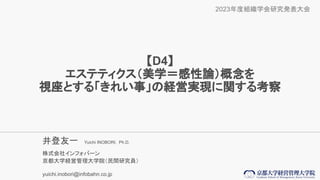


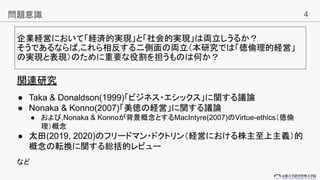
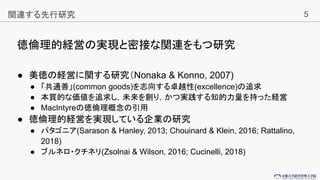
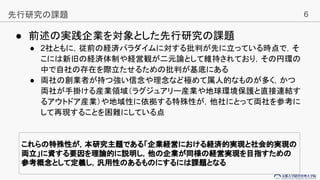
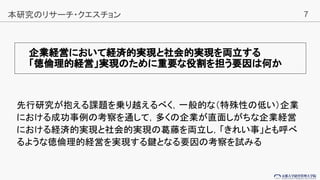
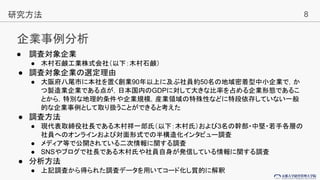
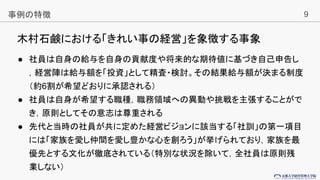
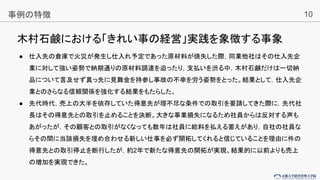
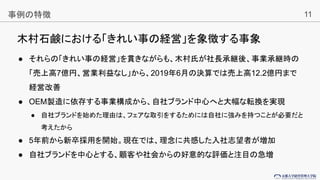
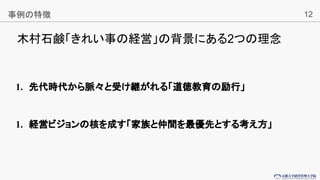
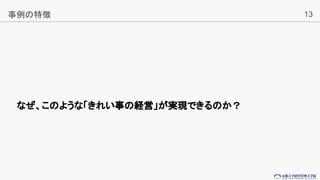


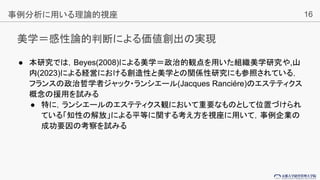
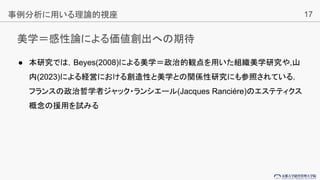

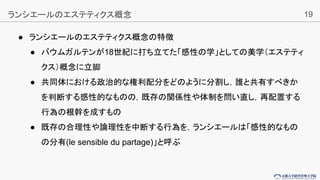
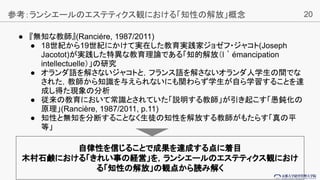

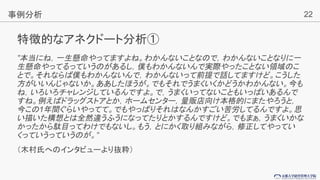
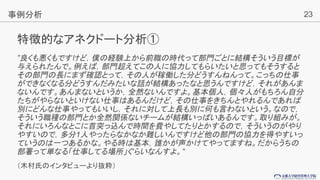
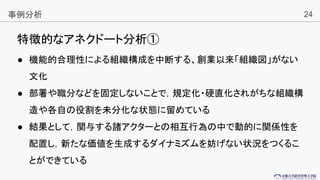
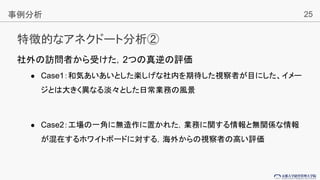


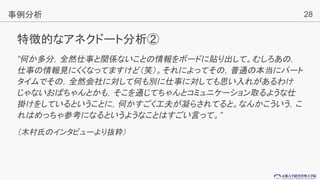




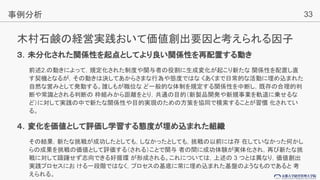
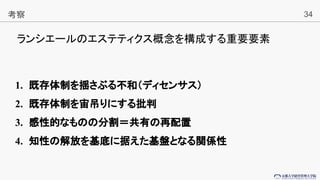
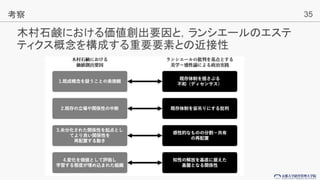
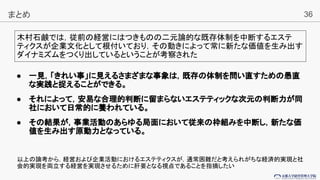
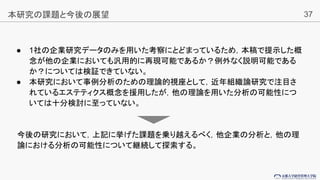
![38
参考文献
Beyes, T. (2008). Reframing the possible: Rancièrian aesthetics and the study of organization. International Journal of Art and Aesthetics in Management and
Organizational Life, 2(1), 32- 41.
Chouinard, Y., & Klein, N. (2016). Let my people go surfing : the education of a reluctant businessman, including 10 more years of business unusual ([2nd
ed.]). Penguin Books.
Cucinelli, B. (2018). Il sogno di Solomeo: La mia vita e la sfida del capitalismo umanistico. Feltrinelli Editore.
Dobson, J. (1999). The art of management and the aesthetic manager : the coming way of business. Quorum Books.
MacIntyre, A. C. (2007). After virtue : a study in moral theory (Third edition). University of Notre Dame Press.
Nonaka, I., & Konno, N. (2007). Bitoku no keiei [Virtuous-based Management]. NTT Publishing. (in Japanese)
Ota, Y. (2019). Kabunushi shijo shugi kara suteiku horuda shugi he no tenkan : Kaisha no mokuteki wo meguru ronso to aratana keiei kihan to shite no ESG
[From Shareholder Supremacy to Stakeholderism - The Debate over Corporate Purpose and ESG as a New Management Norm],
Showajoshidaigakugendaibijinesukiyo [Bulletin of Showa Women’s University Institute of Current Business Studies], 1–13. (in Japanese)
Ota, Y. (2020). Furidoman dokutorin no shuen : Kigyo no sonzai igi no minaoshi to sihonshugi no saikochiku [The End of the Friedman Doctrine: Rethinking
the Meaning of Corporate Existence and the Restructuring of Capitalism], Showajoshidaigakugendaibijinesukiyo [Bulletin of Showa Women’s University
Institute of Current Business Studies], 1–11. (in Japanese)
Rancière, J. (2018). Kaiho sareta kankyaku [Le spectateur émancipé]. (Yu, K., Trans.). Hosei University Press. (Original work published, 2008) (in Japanese)
Rancière, J. (2011). Muchi na kyoushi: Chisei no kaiho ni tsuite [Le ma?tre ignorant : cinq le?ons sur l’émancipation intellectuelle]. (Yu, K., & Yoko, H.,
Trans.). Hosei University Press. (Original works published, 1987) (in Japanese)
Rattalino, F. (2018). Circular advantage anyone? Sustainability-driven innovation and circularity at Patagonia, Inc. Thunderbird International Business Review,
60(5), 747–755.
Sarason, Y., & Hanley, G. (2013). Embedded Corporate Social Responsibility: Can’t We Do Better Than GE, Intel, and IBM? How About a Benefit
Corporation? Industrial and Organizational Psychology, 6(4), 354–358.
Strati, A. (1990). Aesthetics and organizational skill. In B. A. Turner (Ed.), Organizational symbolism (pp.207-222). Walter de Gruyter.
Taka, I., & Donaldson, T. (1999). Bizinesu eshikkusu: Kigyo no shakai teki sekinin to rinri horei jnsyu to manejimento-sisutemu [Business Eehics: Corporate
competitive edge and ethics compliance management system]. Bunshindo. (in Japanese)
Yamauchi, Y(2023). Sozo teki keiei no dezain shiko [Design Thinking of Creative Managers], Sozo suru keieigaku : Sozo sei [Creative Management Science:
Creativity](Kotaro, K. & Keieigakushigakkai (eds.), pp.157-176. (in Japanese)
Zimmerli, M. Holzinger, & K. Richter (Eds.), Corporate Ethics and Corporate Governance (pp. 173–178).
Zsolnai, L., & Wilson, D. (2016). Art-based business. Journal of Cleaner Production, 135, 1534– 1538.](https://image.slidesharecdn.com/2023-230625085840-2d3f23ed/85/-38-320.jpg)
